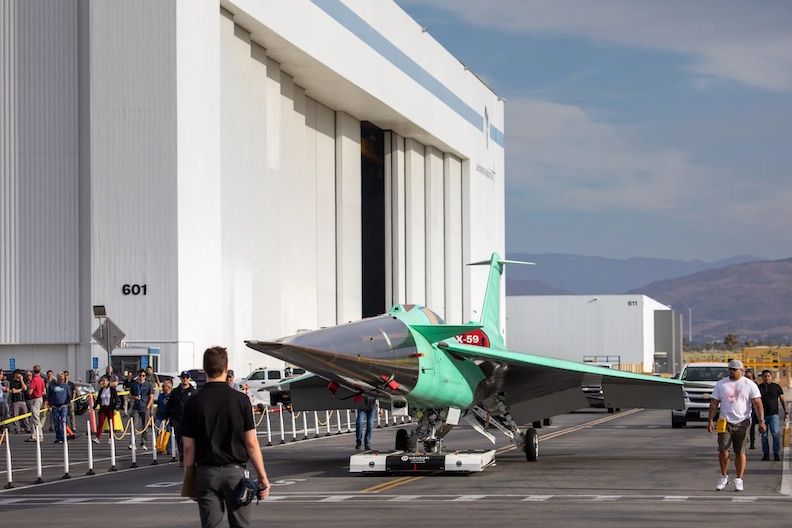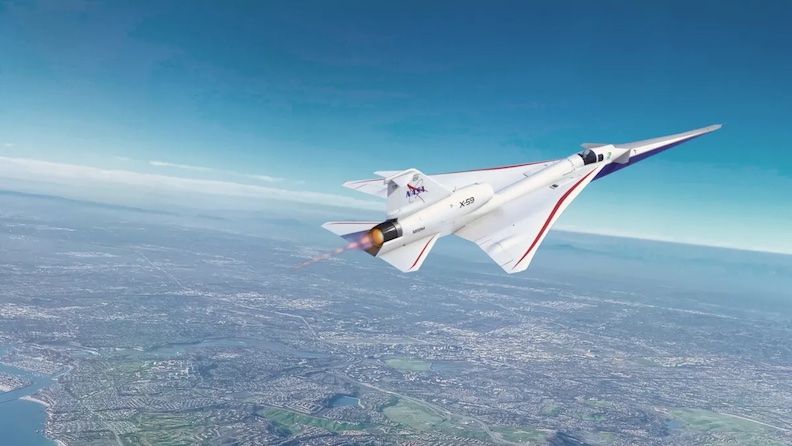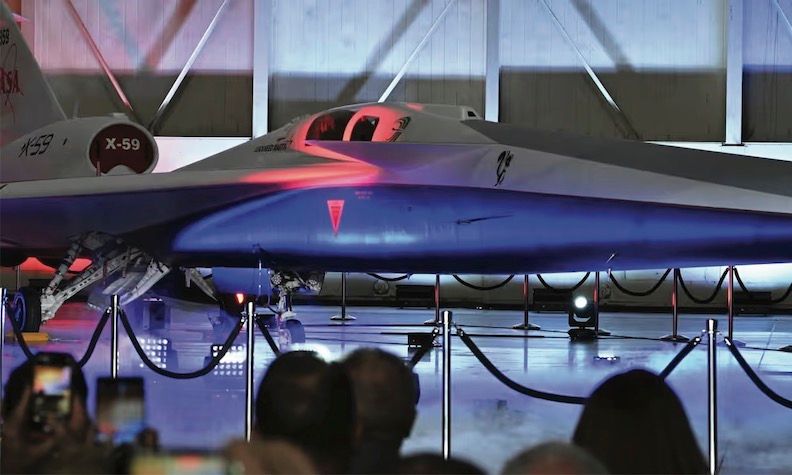NASA & Lockheed Martin Unveiled The Revolutionary, Quiet Supersonic X-59 Plane on Friday: How Quiet Is Quiet Enough?
(Palmdale, California) Executives from NASA, Lockheed Martin (NYSE: LMT) and the California Governor’s Office took to the stage of Lockheed Martin’s Skunk Works Facility on Friday (Jan 12th) night to reveal, after a decade of development, what was described as a truly unique, revolutionary aircraft - the experimental, supersonic X-59, which is designed to cut over-land, cross-country travel time in half by making supersonic flight quiet enough to be permitted by the Federal Aviation Administration (FAA).

Photo courtesy of Lockheed Martin via NASA: NASA’s X-59 research aircraft moved from its construction site to the flight line at Lockheed Martin Skunk Works in Palmdale, California on June 16, 2023.
A tape of the livestream-ed event can be found on NASA’s YouTube channel.
The X-59 is the centerpiece of NASA’s Quesst mission, which seeks to address one of the primary challenges to flight over land by making sonic booms quieter, according to Friday's press release from NASA. Using the experimental X-59 airplane, NASA aims to gather data that could “revolutionize air travel” by paving the way for a new generation of commercial aircraft that can legally travel faster than the speed of sound.
Excecutive Vice President of Lockheed Martin Aeronautics Greg Ulmer explained onstage at Friday’s reveal that Lockheed Martin and NASA - which have been collaborating since NASA’s founding in 1958, and have worked together to support all 22 NASA missions to Mars - have been working to mature the technology necessary to lead up to the introduction of the X-59 (and Friday’s presentation) for the past decade.

Photo courtesy of Lockheed Martin via NASA: NASA’s X-59 quiet supersonic research aircraft sits outside Lockheed Martin’s Skunk Works facility at dawn in Palmdale, California.
Coming away from the presentation, The FLY Report’s key questions involve:
(1) The sufficiency of the X-59 aircraft’s sound attenuation: whether the sound attenuation achieved by NASA and Lockheed via the X-59 will be enough to prove quiet enough for the civilians the airplane is designed to fly over (we certainly hope it is), and
(2) Whether the lack of a forward-facing window in the X-59’s flight deck - and the window's replacement with high resolution cameras feeding a monitor (see details below) - will ultimately prove safe enough to accommodate civilian commercial flight.
The series of presenters at Friday’s reveal, which was emceed by Lockheed Martin Aeronautics’ Director of Government Affairs Eric Fox, demonstrated significant enthusiasm about the potential of the X-59 to redefine the future of quiet, supersonic travel.
“Today we are witnessing history as we roll out the X-59, a unique experimental aircraft designed to quiet the supersonic boom,” said Vice President and General Manager of Lockheed Martin’s Skunk Works John Clark in his introductory presentation.
In a subsequent presentation, NASA's Associate Administrator for the Aeronautics Research Mission Directorate (ARMD) Robert A. Pearce went into detail about the forthcoming roll-out of the X-59, and subsequent plans for testing and data collection. The aircraft's first flight will take place in 2024.
“New innovations have shown that it’s possible to engineer supersonic flight with a soft thump instead of a sonic boom,” Pearce said on-stage. “Our lab studies say yes, but the real answer can only be found by engaging the people who would hear it during daily life.”
The feasibility of the X-59 will be determined once, after a phase of initial tests, the Quesst mission flies the X-59 over U.S. communities in order to collect data from the people below the in-flight aircraft and thereby determine whether the sonic thump is acceptable to U.S. civilians, according to Pearce.

X-59 aircraft rendering courtesy of NASA.
For background, in 1973, the FAA passed CFR § 91.817 - with respect to civil aircraft sonic boom - which prohibits any person from operating a civil aircraft over land in the United States at a speed of greater than Mach 1 (667 knots, or 767 mph), except under certain conditions granted on an individual basis. The FAA explains that it maintains a statutory mandate “to protect the public health and welfare from aircraft noise and sonic boom” per 49 USC 44715.
Pearce went on in his presentation to explain that "in order to be acceptable, supersonic flight must also be sustainable." He emphasized the following:
- Takeoff and landing airport noise should not be louder than that that associated with subsonic aircraft
- High altitude emissions should have minimal or no long-term impact at higher supersonic cruise altitudes
- Efficiencies while in cruise mode must be increased, and sustainable aviation fuels will ultimately reduce emissions further. NASA is pursuing the knowledge for sustainable air travel at any and every speed.
Following Pearce's presentation, NASA Deputy Administrator Pam Melroy continued the presentation, describing the sound produced by the X-59 as a “gentle bump - a mere whisper compared to the booms of the past.”
Melroy continued as the curtain behind her onstage pulled back to reveal the uniquely-shaped, bird-like X-59; with a length of 99.7 feet, the aircraft’s distinct nose comprises about one-third of its length, Melroy explained. (For comparison purposes, a Gulfstream G500 measures about 96 feet in length, an Airbus A380 is approximately 240 feet long, and a Boeing 747 measures about 232 feet.)

Photo by Robyn Beck/AFP/Getty Images courtesy of The Guardian: NASA's and Lockheed Martin's X-59 experimental supersonic jet unveiled during the roll-out ceremony in Palmdale, California, on Friday.
“This design is really critical in disbursing shock waves,” Melroy said. “Today, shocks are formed around the aircraft and then merge together to form a ‘boom.’ By designing the plane to disburse shock waves, they never merge together,” and therefore do not create the “boom” associated with previous supersonic aircraft.
Other particularly unique factors associated with the X-59 are the elimination of a forward-facing window and the positioning of the flight deck (cockpit) almost halfway down the aircraft. The forward-facing window was eliminated as it was “getting in the way of keeping the aircraft quiet,” according to Melroy.
Melroy went on to explain that limited visibility in the cockpit due to lack of a forward-facing window is essentially solved in the X-59 via an external vision system comprised of high resolution cameras feeding what she described as an ultra-high resolution monitor.
“The external vision system has the potential to influence future aircraft designs where the absence of a forward-facing window may prove advantageous for engineering reasons, as it did for us,” Melroy said.
Melroy also pointed out the aircraft’s top-mounted engine - with a deck under the nozzle - which ensures that shock waves don’t merge behind the aircraft and create disruptive shocks below the aircraft.
Additional key X-59 specs from Lockheed Martin’s website include:
- Top speed: approx. Mach 1.4 (925 knots, or 1,064 mph)
- Cruise altitude: 55,000 feet
- Sound level: 75 PLdB (noted on the website as “about as loud as a car door closing”)
- Dimensions: 99’7” long, 26’6” wide and 14” high
Subsequent to Melroy's presentation, Senior Advisor to the California Governor and Director of the Governor’s Office of Business and Economic Development Dee Dee Myers continued onstage, noting the importance of NASA’s partnership with the state of California from an economic perspective, to the tune of $15 billion annually.
“NASA’s partnership with California is so important,” Myers said. “It’s larger than the partnership with any other state and it brings tremendous benefit to our communities.”
Myers explained that the NASA-California state partnership employs approximately 1,800 NASA employees and nearly 3,400 contractors and supply chain workers, with a combined, resulting direct and indirect job force of about 66,000 people state-wide and more than $742 million in annual state revenue.
“The X-59 is the first and only quiet, supersonic aircraft in the world, and no one should be surprised that it was conceived, engineered and built by artisans here in California,” Myers said. "This is ground-zero for innovation and exploration.”
The presentation ended with continued enthusiasm from the respective presenters.
"You’ll be able to take off in New York City, fly at 925 mph, and land 30 minutes before you take off on the New York-Los Angeles route - it’s not exactly time travel, but it’s still pretty cool to think about," Myers said.
“As we embark on this journey, let’s celebrate the X-59 as a symbol of progress and a herald of quieter supersonic travel which will bring us closer together as humans, faster,” NASA Deputy Administrator Melroy said at the conclusion of her speech.
